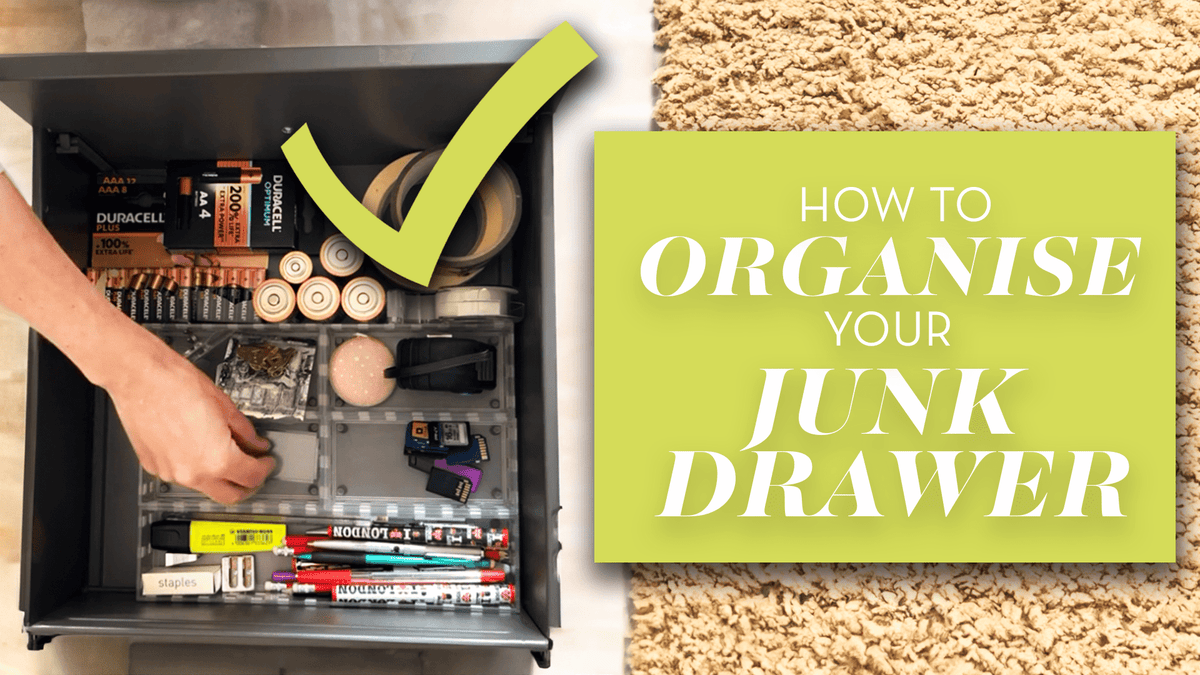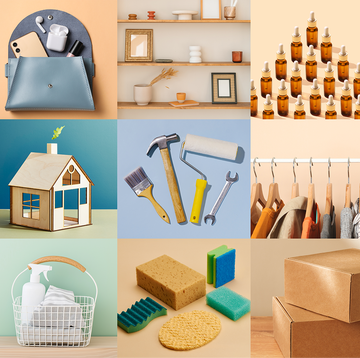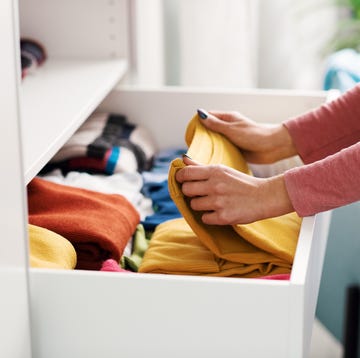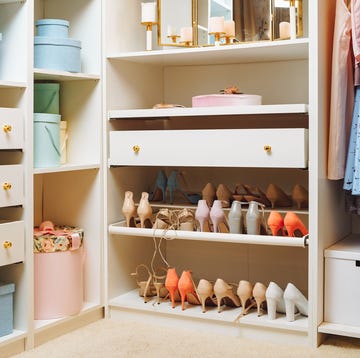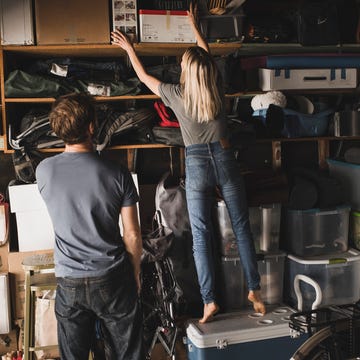As you prepare for the big spring clean, it’s very important to declutter first. It’s best to stick to this order because of the unavoidable mess decluttering can leave behind!
Decluttering is a great way to make some space in the home for the items that really matter. But, as we attempt to sort through what we own, bad habits can quickly develop, for first timers and seasoned clearers alike. In fact, to prepare yourself for potential obstacles, we’ve rounded up the 6 worst habits to break according to the experts, so you can sort through your house like a pro this spring.
1. Biting off more than you can chew
When looking to take on a large decluttering project, things can quickly spiral out of control. Before you know it, you’ve pulled everything out, created a huge mess on the floor and you feel defeated before you’ve even started.
According to Juliet Landau-Pope, productivity coach and author of What’s Your Excuse For Not Clearing Your Clutter?, you should ‘Try to avoid setting grandiose goals or tackling too much in one session. Don’t underestimate the physical and emotional impact of decluttering. For example, it’s not wise to empty out the contents of an entire wardrobe, creating a mountain of clothes on your bed. This strategy might work for dramatic effect on some TV shows but in real life, it’s a surefire recipe for stress and anxiety. Better to deal with one section or sort one category of items at a time.’
Many decluttering techniques agree, and recommend dealing with one category at a time to avoid this problem, including the KonMari method and Swedish Death Cleaning. By working through categories, you get a better idea of the overall volume, gradually achieve a more thorough result and can easily see any duplicates, too.
Always make a plan before you declutter and consider if you’re being reasonable with your expectations in the time you have.
2. Churning
If you’re new to decluttering and find you’re struggling to let things go, ‘churning’ is a natural response. This happens when you can’t come to a decision and want to return to the item(s) later.
Landau-Pope continues: ‘[Don’t] move things around while sorting, putting them in piles “just for now” in the hope that you’ll have the motivation to look at them later. This is termed “churning” – it might give the impression that you’re tackling stuff, but you’re not reducing clutter by deferring decisions.’
By churning, you’re left with a collection of items sitting around the home that you never get around to removing. Previously, I’ve had bin bags of clothes sitting in the front room for so long that I’ve had to re-sort through them to remind myself of what they are and finally let them go. In other cases, the items might even get gradually integrated back into the home.
Lynda Wylie, professional organiser from Tidy Rooms, says: ‘Initially, the most helpful solution here can be to ask someone else (a professional/partner/friend) to take the items away for you. This helps create space and progress quickly and encourages you to continue sorting and discarding.
‘Finding a way that works for you going forward is the longer-term goal. Consider what’s stopping you from taking the unwanted items away.’
‘Always put things immediately into the boot of the car, so they’re readily to hand when passing a charity shop or recycling centre. Or move things to go as close to your front door as possible – without creating a trip hazard! If you stack them neatly out of the way they could easily get forgotten about or reabsorbed. The key is to make it easy for yourself, so discarding doesn’t become a barrier to letting go.’
3. Getting lost down memory lane
While decluttering, have you ever stumbled on an old photo album or souvenir and found yourself thinking back over your memories? Before you know it, you’ve lost an hour and you’re left sitting in a sea of clutter, disheartened.
Landau-Pope says: ‘One of the most distracting habits to avoid is reading letters and diaries. However curious you are, resist the temptation to head down memory lane. There’s no end to the time it might take or the emotions they’ll stir up. Put them aside to savour later when you take a break.’
Sentimental items are the hardest to declutter because of the emotional ties they have. If they still have worth to you, you obviously don’t have to declutter them. The most precious of items should be stored or displayed safely and securely, so you know exactly where to find them.
If you have an overhaul of sentimental items, consider how much value each item has for you. For instance, when I returned home from a holiday recently, I found I’d brought back some important souvenirs, alongside other less necessary things I’d collected from the hotel (pens, bags and notepads etc). I had a plethora of such items, so storing them was pointless – I already had my memories.
4. Relying on storage solutions
Storage solutions are brilliant for making the most of a limited space, but they can be a bad influence if you’re storing more than you need.
Helen Sanderson, The Clutter Therapist and author of The Secret Life Of Clutter says: ‘A prime example [of a bad habit] is buying storage solutions too soon – without first clearing out what you no longer need, you’re just reorganising clutter rather than eliminating it. I encourage clients to follow my ‘weed, plant, maintain’ approach: clear the excess, establish practical organisation systems, and sustain those systems over time with consistent habits. It’s vital to complete each phase before moving to the next.’
Wylie agrees: ‘[Pre-emptive storage solutions] means more is kept and it complicates the simplification process. Always pick an area or category to sort out first, then divide your belongings into keep, go or not sure. Next, consider where it’s best to store your keepers so they’re most easily accessible before deciding what to contain them in. Otherwise, you’ll find you store more than you need or love and can easily spend hours dividing and sorting things into beautiful storage that cannot contain it all, has no clear space to live and hasn’t simplified your home.’
My wardrobe is a prime example of this problem. I purchased shoe racks to organise my shoes beneath the hanging rail, but I had so many shoes that I wanted to keep that I ended up stacking two racks. The trouble with this was my coats and dresses ended up draping over the shoes on the top shelf! So only consider storage solutions after you’ve removed the excess and make sure it’s a practical fit for your space.
5. Holding on to things, ‘just in case’
We’ve all been there – you know you’re dealing with an item you should really declutter, but a niggling voice in the back of your mind tells you to hang on to it ‘just in case’. This is a common problem, and there’s no way to know if you really will need that item, but if you haven’t needed it recently, or maybe forgot about it entirely, odds are, you can remove it.
Landau-Pope says: ‘Holding on to items that you think you might use at some undefined point in the future [is a bad habit]. Remember that “some day” isn’t a day of the week! If you have a specific occasion in mind, it’s fine. But it you can’t think of a particular occasion when you’d wear or use something, maybe it’s time to let it go.’
From personal experience, there have only been a couple of occasions where I’ve decluttered things I’ve later regretted. I once removed 14 ramekins during the Minimalism Game, only to find I needed one a few weeks later! It wasn’t the end of the world – I found an alternative solution, but in most cases, the extra space gained outweighs the potential for regret. Making sure that you’re considering the true value of each item as you declutter can avoid this, and holding back one ramekin!
6. Self-criticism
Finally, if you find yourself judging yourself as you declutter, you’re not alone. Self-criticism is a common habit that people need to break, according to Landau-Pope:
‘The most vital habit to avoid while decluttering is self-criticism. Surveying the surplus stuff in your home can give rise to so much judgement and shame. You might berate yourself for buying things that you barely used. Or feel hopeless and hapless because you’ve allowed so much clutter to accumulate. My top tip is to brace yourself for negative emotions, and to make concerted efforts to be kind to yourself. Compassion is more motivating than criticism so commend yourself for taking steps to create changes and try to focus on positive self-talk.’
If you find yourself struggling with the emotional turmoil of decluttering, taking regular breaks and pacing yourself can help. Sanderson adds: ‘Breaking the work into manageable chunks and staying accountable to your decluttering commitment is key to real, lasting change.’
Decluttering takes time and it can take its toll on your emotions, but by being consistent, you’ll gradually find the task easier. And, by revisiting it regularly and watching you don’t cycle back to a cluttered home, it can feel like less of a burden.










